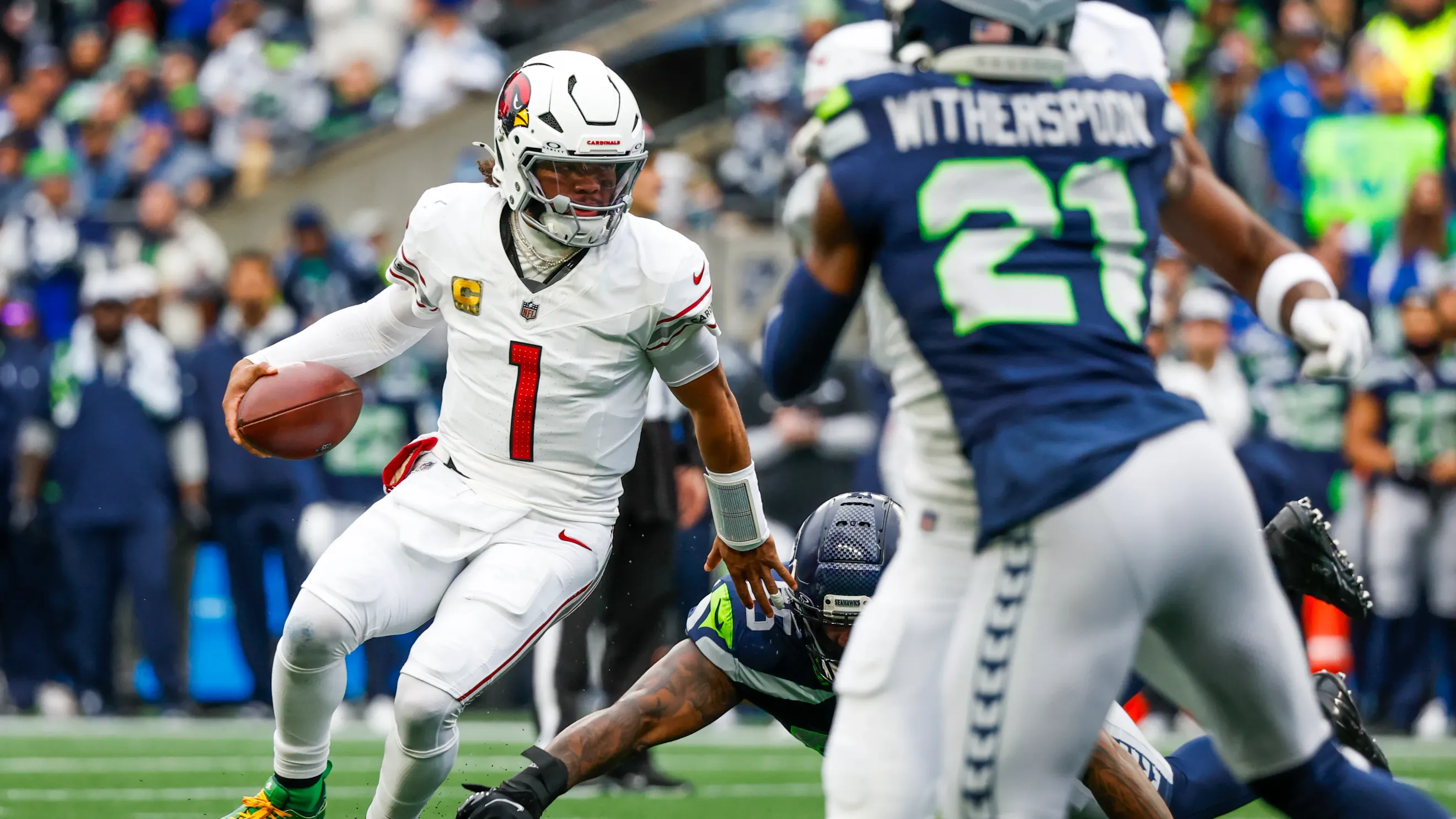
Quick Slant: TNF - A Hammer Falling on the Same Anvil
Mat Irby’s Quick Slant
Since Arizona moved from the East (where they were always peculiar) and Seattle from the AFC, the Seahawks and Cardinals have worked dutifully to manufacture rivalry from thin air. Recently, it has been as one-sided as rain on stone. Rivalries flourish on mutual exchanges—on the tension that no role is permanent. But this series has been a hammer falling on the same anvil. Seattle has won seven straight, treating the Cardinals like a routine—like trimming their nails, or flossing their teeth—their victories stacked like firewood.
Repetition shapes belief. When Seattle lines up against Arizona, victory feels foregone. Any sports fan can attest: belief can be a far greater energy than ability; we see it time and time again. Confidence can smother hesitation like mud before the numb shock of the first crack of pads has even been administered.
For Arizona, this feeling is hard to overcome. Each new meeting with Seattle must feel more like burden than opportunity. Is this the night we finally smack this bully in the mouth, or are we being tossed aside yet again? Rivalries turn into streaks, streaks into curses, and curses become self-fulfilling. Even with a mindset carefully fixed on a new beginning, every dropped pass, penalty, and blown assignment presses like currents against a failing dam. Soon, the struggle turns familiar, and the fight slips yet again from their bellies, resting instead in wobbly knees. Same story, same ending, no matter how we come at it.
Seattle plays its part too, and it’s a comfortable one. Certainties are rare for the Seahawks in the post-Wilson era, but Arizona is one; you can hang your hat on that, at least. But this time feels different. The Cardinals carry a focus, a threat. And for the first time in years, neither team is buried in the silt beneath the West. Seattle, long lost to mediocrity, finally shows a pulse. Could both teams be… relevant?
Strange as it may seem, the NFC West has arguably been the best division in football through the first three weeks. We viewers are programmed to see through Thursday nights like this, but this one might be different. In the end, we may look back and see it clearly: this was a game that mattered.
Seahawks
Implied Team Total: 22.5
The Seahawks are surprising, to say the least. If you haven’t been paying attention, it’s honestly pretty surprising how surprising they’ve been. They have the best point differential in the NFL, meaning they have the highest expected wins based on the Pythagorean wins model.
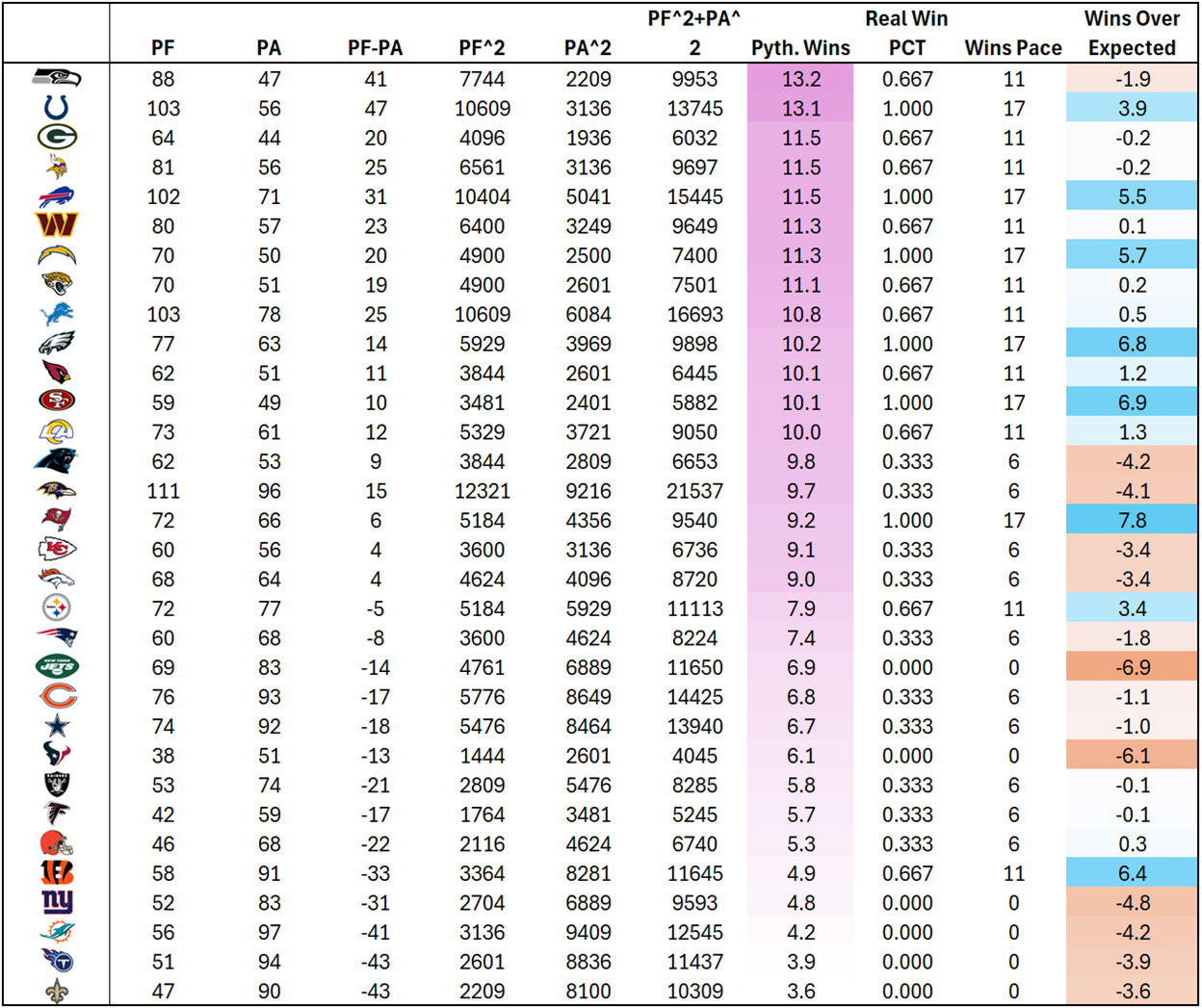
The Seahawks have been one of the run-heaviest teams in the NFL, carrying a -7.08% pass rate over expected (PROE, 31st).
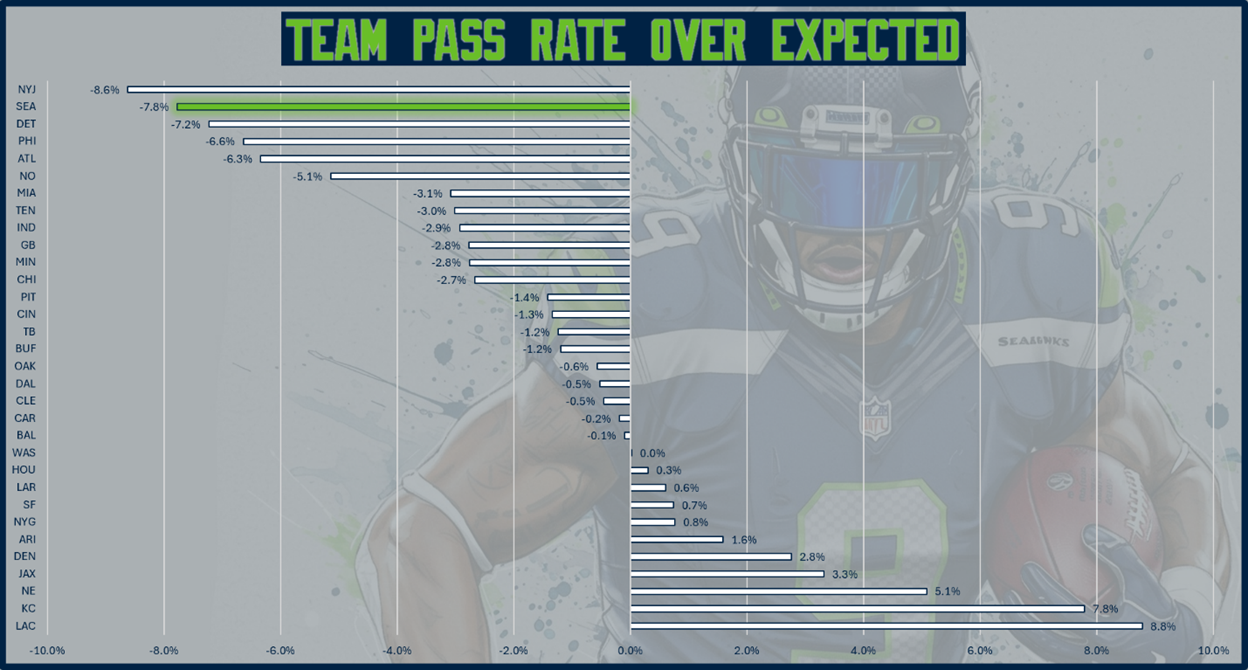
From a neutral script, the Seahawks have a run rate of 47% (T-8th), which is high but not exorbitant. From a lead of seven or more, all teams naturally increase their run rate, but the Seahawks increase at a greater rate than most, jumping to 67% (T-4th). Notably, this data places them behind the Jets and Eagles, who have only led by such a margin for a combined eight plays—a minimal sample size.
Seattle, on the other hand, has had 61 offensive snaps from such a lead, which is among the most in the league. The combination of their increased run rate and the frequency of plays at this advantage makes them a run-heavy team. It is within the realm of possibility that, if they remain in closer scripts, they will play slightly more balanced.
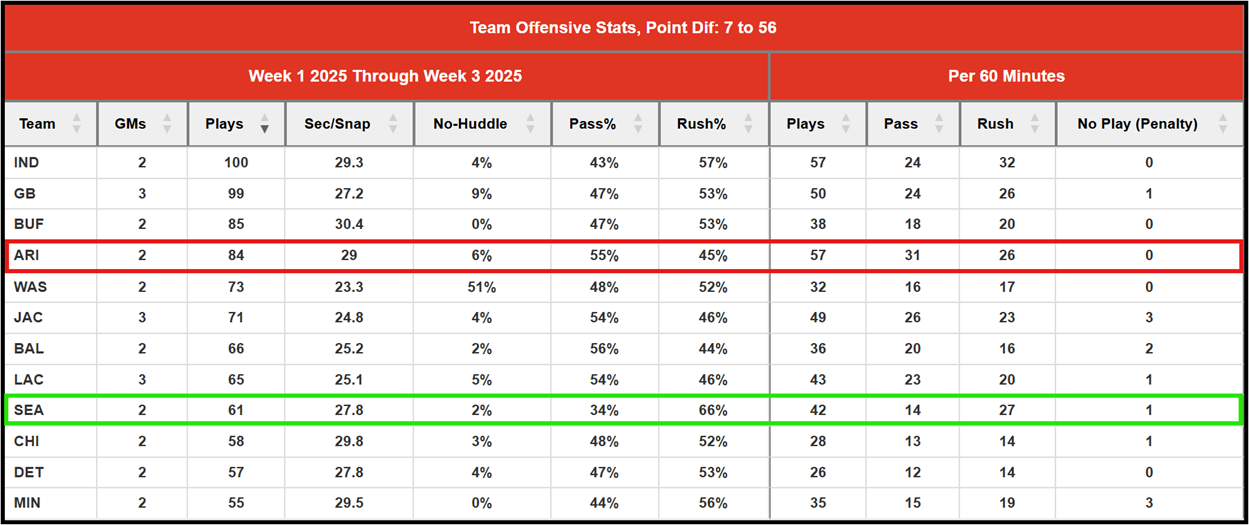
Their expenditure of time at this type of lead also leads them to a lower play volume; Seattle has only 174 offensive snaps this season (T-5th).
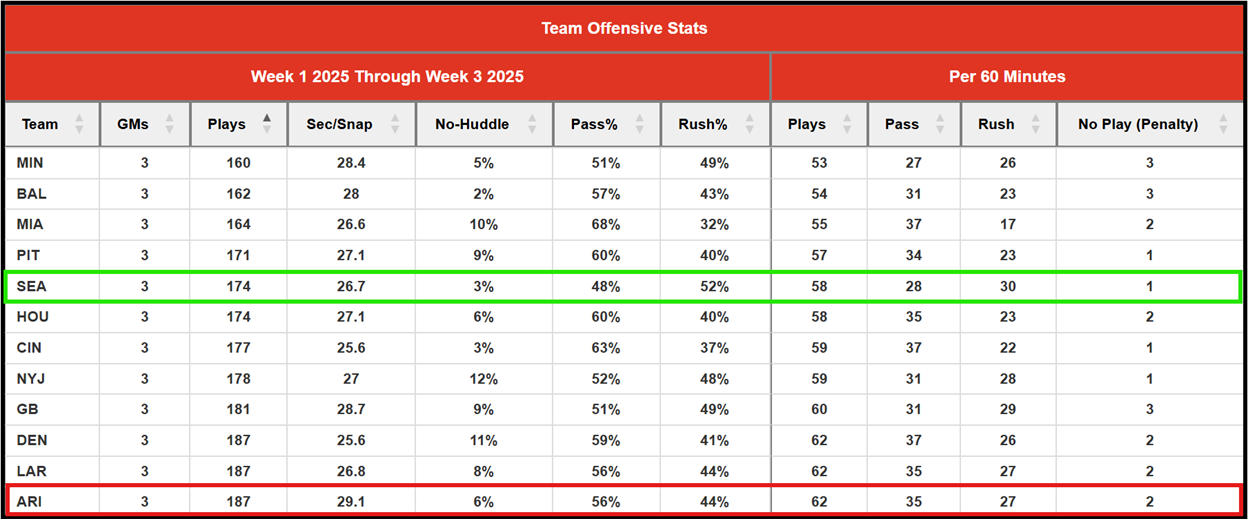
Coming off a bludgeoning of New Orleans, one of the two worst teams in the league thus far, it is right to ask questions about the quality of Seattle’s opponents. In Week 2, they also broke the Pittsburgh Steelers, a team that has been, more or less, middle-of-the-pack, if not slightly below average. But in Week 1, they barely dropped one to the division leader, the undefeated 49ers. The quality of their opponents has been on the lower end on average; however, their schedule has not been laughable.
Undoubtedly, some critics argued this summer that QB Sam Darnold could not sustain his momentum after finishing tenth in MVP voting with Minnesota last year, then switching teams and leaving the performance-enhancing biosphere of HC Kevin O’Connell’s offensive system behind. But in Seattle, he has only continued to thrive; Darnold currently ranks fourth in EPA + CPOE composite.
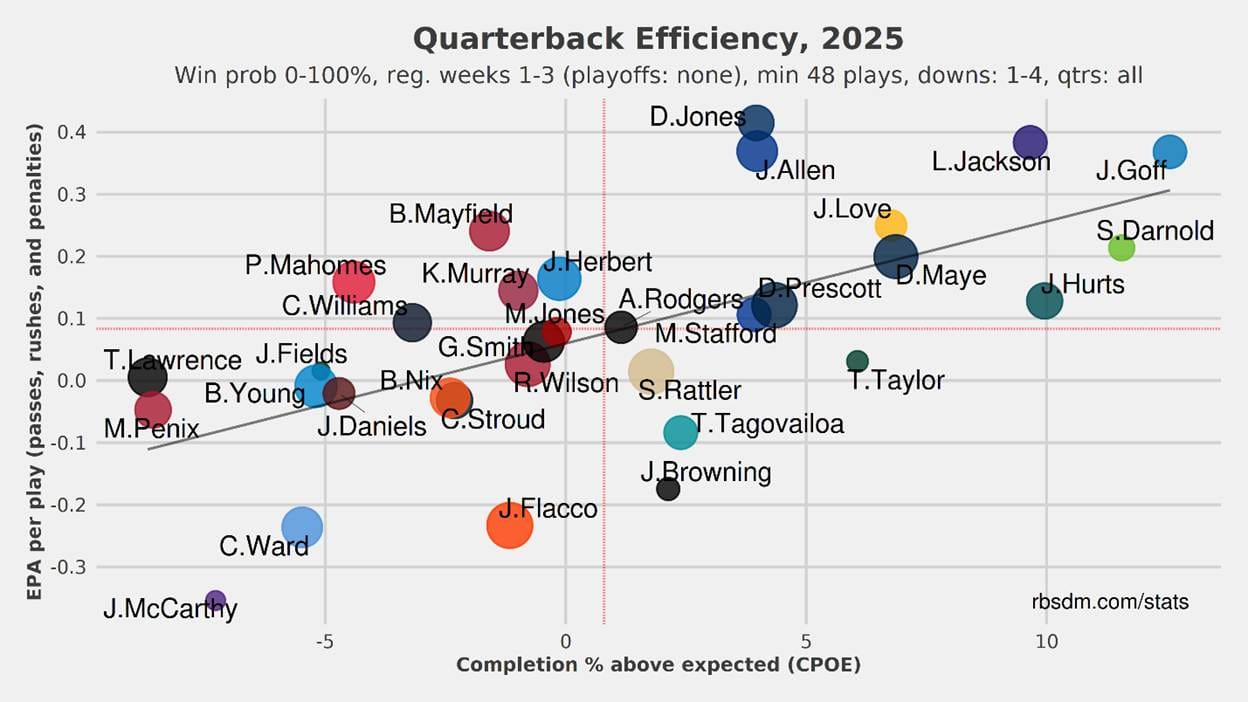
With lower play volume and a lack of a mobility component, Darnold is a better real-life QB than a fantasy one; he has just 0.3 Expected Fantasy Points (T-41st) according to Fantasy Points’ expected points model (XFP). Fantasy Points' XFP is one of the most stable underlying metrics in all of fantasy football.
Additionally, he ranks 21st in fantasy points among QBs. Pocket passers, such as Darnold, must maintain high TD rates to be particularly relevant, and fantasy production typically comes from volume, which the Seahawks may not provide. This is all why, regardless of matchup, it is hard to trust Darnold in fantasy outside of two-QB or Superflex settings.
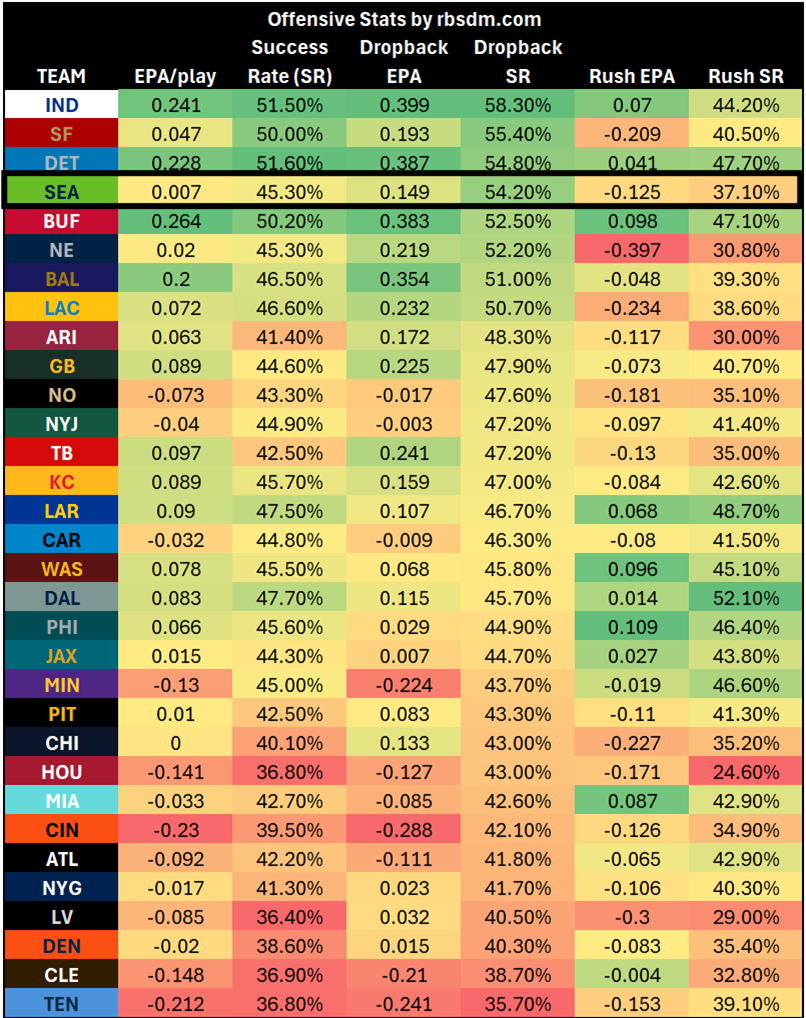
One thing in Darnold’s favor is that the Seahawks have kept him clean this season. In fact, the Seahawks’ pass-blocking has been one of the most surprising units for any team all season; generally, most pundits assumed the Seahawks’ line would be among the worst. But between their improvement and OC Klint Kubiak’s system, they’ve swung back to 11th-best in terms of pressure rate over expected (PrROE) allowed. According to Fantasy Points’ OL/DL Matchup data, Seattle is expected to enjoy the second-most-significant offensive pass blocking advantage in Week 4.
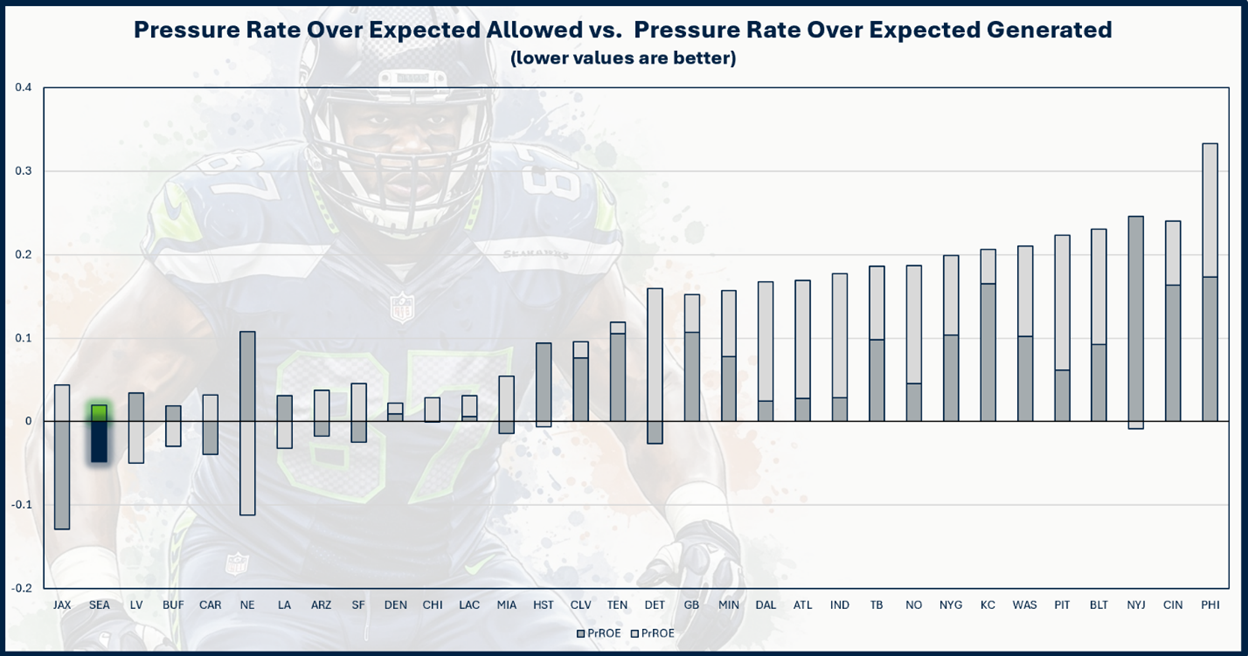
The Cardinals primarily run a zone defense (74.7%, 14th) with a two-high safety look (57.3%, 7th). Their most common alignments are Cover 3 and Cover 4 zone, which they run at 27.8% apiece.
Against the types and rates of coverage the Cardinals employ defensively, Darnold matches neutrally. According to Fantasy Points’ expected fantasy points/dropback (FP/DB) model, he has the 15th-best matchup on paper, with an expected 0.44 FP/DB.
The Cardinals are unlikely to blitz Darnold; they have the fourth-lowest blitz rate in the league this year (14.9%). Their preference will be to let their players try to win in coverage, which may not go so hot; the Cardinals rank 28th in defensive EPA per DB allowed.
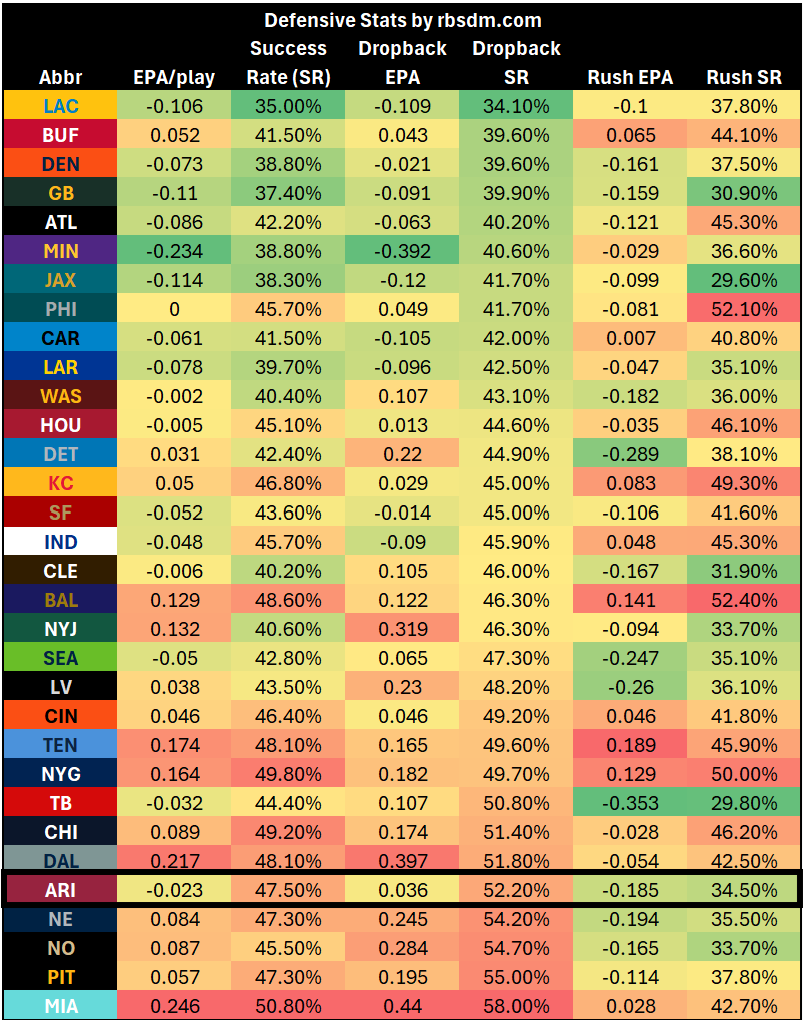
We should expect Darnold to have clean pockets for most of the game. Against two-high Cover 3 or Cover 4 zone looks without blitzers, Darnold has had 14 dropbacks, scoring 0.37 FP/DB. From such dropbacks last year, Darnold ranked 8th in first downs (22) and fourth in air yards (549). Darnold may be nearly impossible to trust in redraft, but this could be a good matchup for him in DFS or in two-QB/Superflex leagues. Of course, so much of his potential boils down to TD luck, so individual tolerance for variance looms large.
The Seahawks drafted WR Jaxon Smith-Njigba with the 20th overall pick in 2023; he has steadily progressed, but he appears poised for a significant leap forward this season already. He leads all WRs in market share through three weeks (40%).
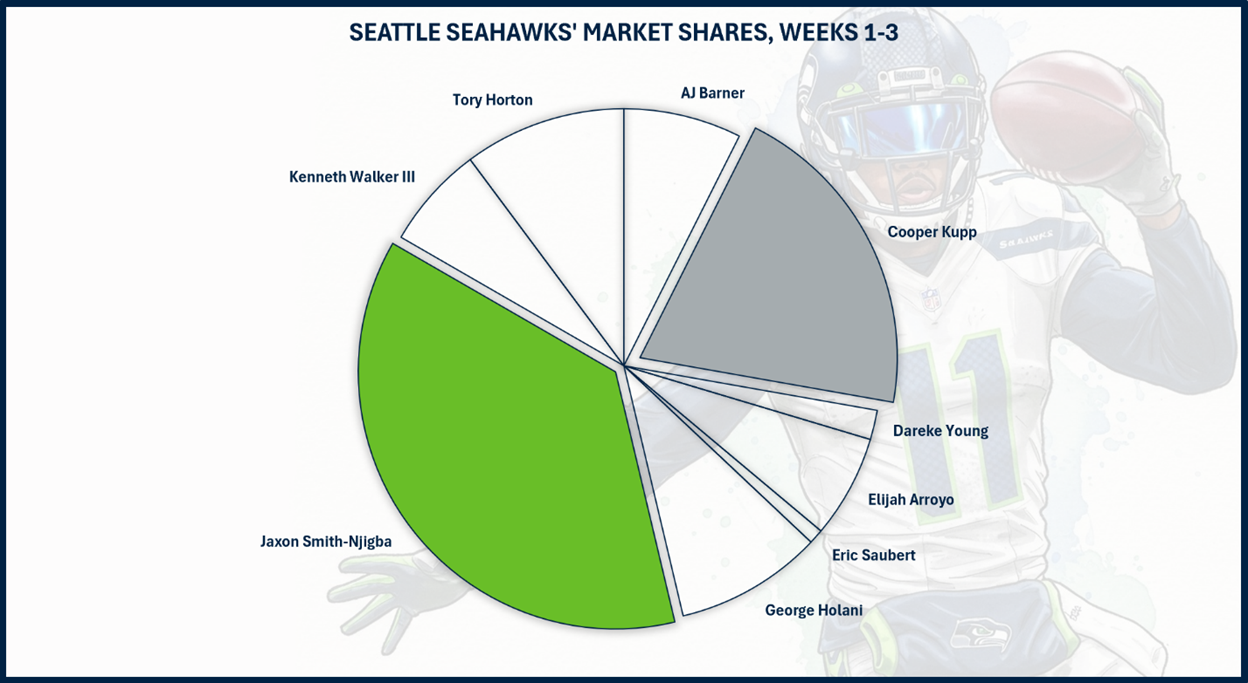
Smith-Njigba and WR Cooper Kupp (22%) have combined for 62%, a narrow target distribution. Of course, they have been somewhat harmed thus far by a lack of volume, as Darnold has only dropped back 79 times (29th). Smith-Njigba’s inflated target rate still directs his total volume to elite territory; he has 28 targets (T-5th) through three games.
For Kupp, however, a 22% slice of a mediocre total pass volume has resulted in just 13 targets (T-83rd), tied with RB Javonte Williams, TE Jonnu Smith, and RB Cam Skattebo, among others. As an added stressor, Kupp might find rookie WR Tory Horton increasingly nipping at his heels as the weeks go by. Horton already had more targets in Week 3, along with a receiving TD (and a return TD). In redraft and especially in dynasty leagues, Kupp is a total ripcord pull.
Thus far in 2025, Smith-Njigba has excelled against the types and rates of coverage the Cardinals run; he ranks first in Fantasy Points’ expected FP/RR model this week with 1.17 expected FP/RR. Smith-Njigba ranks eighth in FP/RR against Cover 3 zone (0.70) and second against Cover 4 zone (with an astounding 1.87 FP/RR). Against two-high Cover 3 or Cover 4 looks with no blitz, Smith-Njigba has the eighth-most FP/RR.
Last season, Smith-Njigba ran 83 routes against such a combination of factors, earning 205 rec YDS (4th), 106 YAC (2nd), and nine first downs (T-6th).
Smith-Njigba is expected to have a great matchup against the Arizona personnel, according to PFF’s matchup tool; PFF expects him to line up primarily against CB Denzel Burke. Kupp’s matchups grade out as good, with his primary adversary expected to be S Jalen Thompson. Horton’s matchup grades out as fair.
One of the most challenging situations to diagnose in all of fantasy is the backfield split for Seattle. RB Zach Charbonnet came out of the gate with a much larger share of the workload than many people anticipated; in Week 2, Charbonnet was a disaster. In Week 3, when Charbonnet was out with an injury, most assumed RB Kenneth Walker would eat; while he had a meaningful fantasy day, two TDs saved a white-knuckle 2.4 YPC stress-inducer.
|
|
Week 1 Opps |
Week 1 FP |
Week 2 Opps |
Week 2 FP |
Week 3 Opps |
Week 3 FP |
|
K. Walker |
13 |
5.4 |
14 |
18.8 |
17 |
18.0 |
|
Z. Charbonnet |
13 |
10.7 |
15 |
1.0 |
NA |
NA |
It is certainly fair to still wonder how the backfield will break down for Seattle, although the most likely scenario is that they will continue to meet the same status quo they did in their first two games together, when each got about half of the work.
One thing in Walker’s favor thus far is that he is in control of the backfield targets, as Charbonnet has earned zero targets through two outings, although even Walker’s shares have been modest, with just five in three games.
The Cardinals have thus far been better at stopping the run than the pass in terms of efficiency, but they’ve been very generous in terms of expected points (EP).
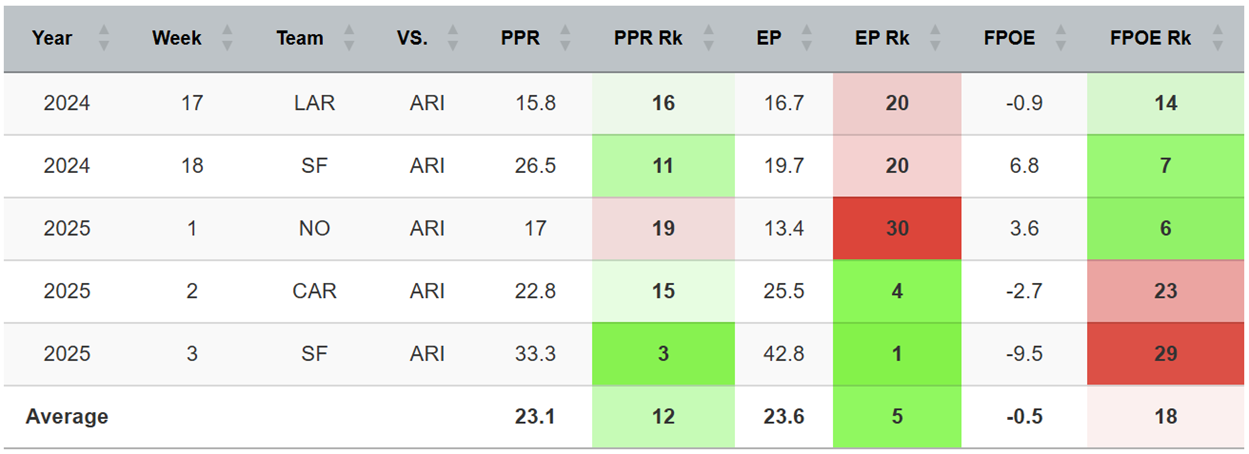
The Cardinals have been particularly vulnerable against pass-catching RBs in their last five games. Regardless, it is not evident that the Seahawks have an RB who could take advantage.
